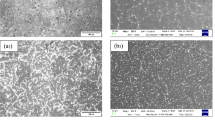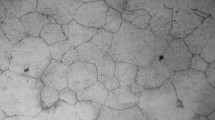Abstract
In the present work, ribbon and 2-mm rod samples of Mg–Zn–Ca–Mn alloys were prepared by melt-spinning and copper mold injection methods, respectively. Effects of Mn doping on glass-forming ability and corrosion performance in simulated body fluid of Mg65Zn30Ca5 alloy were studied through X-ray diffraction, scanning electron microscopy, differential scanning calorimeter, and electrochemical and immersion tests. Results show that with the Mn addition increasing, all the ribbon samples are completely in amorphous state. However, the microstructure of 2-mm rod samples transfers from fully amorphous for the Mn-free alloy to almost polycrystalline state with precipitated Mg, Mn, and MgZn phases. Glass-forming ability of Mg65Zn30Ca5 alloy is decreased by Mn addition. Results of electrochemical and immersion tests demonstrate that the Mn-doped samples exhibit more negative corrosion potential and larger corrosion current density, suggesting that the corrosion resistance decreases with doping amount of Mn element increasing.






Similar content being viewed by others
References
Hong D, Saha P, Chou DT, Lee B, Collins BE, Tan ZQ, Dong ZY, Kumta PN. In vitro degradation and cytotoxicity response of Mg–4%Zn–0.5%Zr (ZK40) alloy as a potential biodegradable material. Acta Biomater. 2013;9(10):8534.
Staiger MP, Pietak AM, Huadmai J, Dias G. Magnesium and its alloys as orthopedic biomaterials: a review. Biomaterials. 2006;27(9):1728.
Vormann J. Magnesium: nutrition and metabolism. Mol Aspects Med. 2003;24(1–3):27.
Kraus T, Fischerauer SF, Hänzi AC, Uggowitzer PJ, Löffler JF, Weinberg AM. Magnesium alloys for temporary implants in osteosynthesis: in vivo studies of their degradation and interaction with bone. Acta Biomater. 2012;8(3):1230.
Choi YI, Salman S, Kuroda K, Okido M. Improvement in corrosion characteristics of AZ31 Mg alloy by square pulse anodizing between transpassive and active regions. Corros Sci. 2012;63:5.
Jamesh M, Kumar S, Narayanan TSNS. Corrosion behavior of commercially pure Mg and ZM21 Mg alloy in Ringer’s solution—long term evaluation by EIS. Corros Sci. 2011;53(2):645.
Erbel R, Di MC, Bartunek J, Bonnier J, Bruyne BD, Eberli FR, Erne P, Haude M, Heublein B, Horrigan M, Ilsley C, Böse D, Koolen J, Lüscher TF, Weissman N, Waksman R. Temporary scaffolding of coronary arteries with bioabsorbable magnesium stents: a prospective, non-randomised multicentre trial. The Lancet. 2007;369(9576):1869.
Witte F, Fischer J, Nellesen J, Crostack HA, Kaese V, Pisch A, Beckmann F, Windhagen H. In vitro and in vivo corrosion measurements of magnesium alloys. Biomaterials. 2006;27(7):1013.
Li H, Peng Q, Li X, Han ZS, Fang DQ. Microstructures, mechanical and cytocompatibility of degradable Mg–Zn based orthopedic biomaterials. Mater Des. 2014;58:43.
Yang Z, Yuan G, Zhang X, Mao L, Niu JL, Ding WJ. Comparison of biodegradable behaviors of AZ31 and Mg–Nd–Zn–Zr alloys in Hank’s physiological solution. Mater Sci Eng B. 2012;177(5):395.
Zhang W, Li M, Chen Q, Hu WY, Zhang WM, Xin W. Effects of Sr and Sn on microstructure and corrosion resistance of Mg–Zr–Ca magnesium alloy for biomedical applications. Mater Des. 2012;39:379.
Gu Y, Bandopadhyay S, Chen CF, Ning CY, Guo YJ. Long-term corrosion inhibition mechanism of microarc oxidation coated AZ31 Mg alloys for biomedical applications. Mater Des. 2013;46:66.
Jiang WH, Jiang F, Green BA, Liu FX, Liaw PK. Electrochemical corrosion behavior of a Zr-based bulk-metallic glass. Appl Phys Lett. 2007;91(4):1177.
Gu X, Zheng Y, Zhong S, Xi TF, Wang JQ, Wang WH. Corrosion of, and cellular responses to Mg–Zn–Ca bulk metallic glasses. Biomaterials. 2010;31(6):1093.
Trumbo P, Yates AA, Schlicker S, Poos M. Dietary reference intakes: vitamin A, vitamin K, arsenic, boron, chromium, copper, iodine, iron, manganese, nickel, silicon, vanadium and zinc. J Am Diet Assoc. 2001;101(3):294.
Zberg B, Uggowitzer PJ, Löffler JF. MgZnCa glasses without clinically observable hydrogen evolution for biodegradable implants. Nat Mater. 2009;8(11):887.
Ramya M, Sarwat SG, Udhayabanu V, Subramanian S, Raj B, Ravi KR. Role of partially amorphous structure and alloying elements on the corrosion behavior of Mg–Zn–Ca bulk metallic glass for biomedical applications. Mater Des. 2015;86:829.
Li HF, Pang SJ, Liu Y, Liaw PK, Zhang T. In vitro investigation of Mg–Zn–Ca–Ag bulk metallic glasses for biomedical applications. J Non-Cryst Solids. 2015;427:134.
Zhang E, Yin D, Xu L. Microstructure, mechanical and corrosion properties and biocompatibility of Mg–Zn–Mn alloys for biomedical application. Mater Sci Eng C. 2009;29(3):987.
Xu L, Yu GE, Pan F. In vivo corrosion behavior of Mg–Mn–Zn alloy for bone implant application. J Biomed Mater Res A. 2007;83(3):70.
Kakubo T, Takadama H. How useful is SBF in predicting in vivo bone bioactivity? Biomaterials. 2006;27(15):2907.
Song G. Control of biodegradation of biocompatable magnesium alloys. Corros Sci. 2007;49(4):1696.
Wang J, Li Y, Huang S. Effects of Y on the microstructure, mechanical and bio-corrosion properties of Mg–Zn–Ca bulk metallic glass. J Mater Sci Technol. 2014;30(12):1255.
Wang YS, Tan MJ, Pang JJ, Wang ZM, Jarfors AWE. In vitro corrosion behaviors of Mg67Zn28Ca5 alloy: from amorphous to crystalline. Mater Chem Phys. 2012;134(2–3):1079.
Inoue A. Stabilization of metallic supercooled liquid and bulk amorphous alloys. Acta Mater. 2000;48(1):279.
Turnbull D. Under what conditions can a glass be formed? Contemp Phys. 1969;10(5):473.
Lu ZP, Liu CT. A new glass-forming ability criterion for bulk metallic glasses. Acta Mater. 2002;50(13):3501.
Zhang QS, Zhang HF, Deng YF, Ding BZ, Hu ZQ. Bulk metallic glass formation of Cu–Zr–Ti–Sn alloys. Scr Mater. 2003;49(4):273.
Xie KF, Yao KF, Huang TY. A Ti-based bulk glassy alloy with high strength and good glass forming ability. Intermetallics. 2010;18(10):1837.
Zhang ZY, Wu Y, Zhou J, Song WL, Cao D, Wang H, Liu XJ, Lu ZP. Effects of Sn addition on phase formation and mechanical properties of TiCu-based bulk metallic glass composites. Intermetallics. 2013;42(11):68.
Li Z, Gu X, Lou S, Zheng YF. The development of binary Mg–Ca alloys for use as biodegradable materials within bone. Biomaterials. 2008;29(10):1329.
Hofstetter J, Martinelli E, Pogatscher S, Schmutz P, Povoden-Karadeniz E, Weinberg AM, Uggowitzer PJ, Löffler JF. Influence of trace impurities on the in vitro and in vivo degradation of biodegradable Mg–5Zn–0.3Ca alloys. Acta Biomater. 2015;23:347.
Li X, Liu X, Wu S, Yeung KWK, Zheng YF, Chu PK. Design of magnesium alloys with controllable degradation for biomedical implants: from bulk to surface. Acta Biomater. 2016;45:2.
Wu GH, Gao HT, Ding WJ, Zhu YP. Study on mechanism of iron reduction in magnesium alloy melt. J Mater Sci. 2005;40(23):6175.
Ahmad Z. Principles of Corrosion Engineering and Corrosion Control. Oxford: Butterworth-Heinemann; 2006. 20.
Acknowledgements
This study was financially supported by the National Natural Science Foundation of China (Nos. 51201120 and 51401155), the Science & Technology Coordination & Innovation Project of Shaanxi Province (No. 2016KTZDGY-04-01) and the Key Laboratory Program Funded by Shaanxi Provincial Education Department (No. 17JS053).
Author information
Authors and Affiliations
Corresponding author
Rights and permissions
About this article
Cite this article
Wang, JL., Wan, Y., Ma, ZJ. et al. Glass-forming ability and corrosion performance of Mn-doped Mg–Zn–Ca amorphous alloys for biomedical applications. Rare Met. 37, 579–586 (2018). https://doi.org/10.1007/s12598-018-1032-z
Received:
Revised:
Accepted:
Published:
Issue Date:
DOI: https://doi.org/10.1007/s12598-018-1032-z




